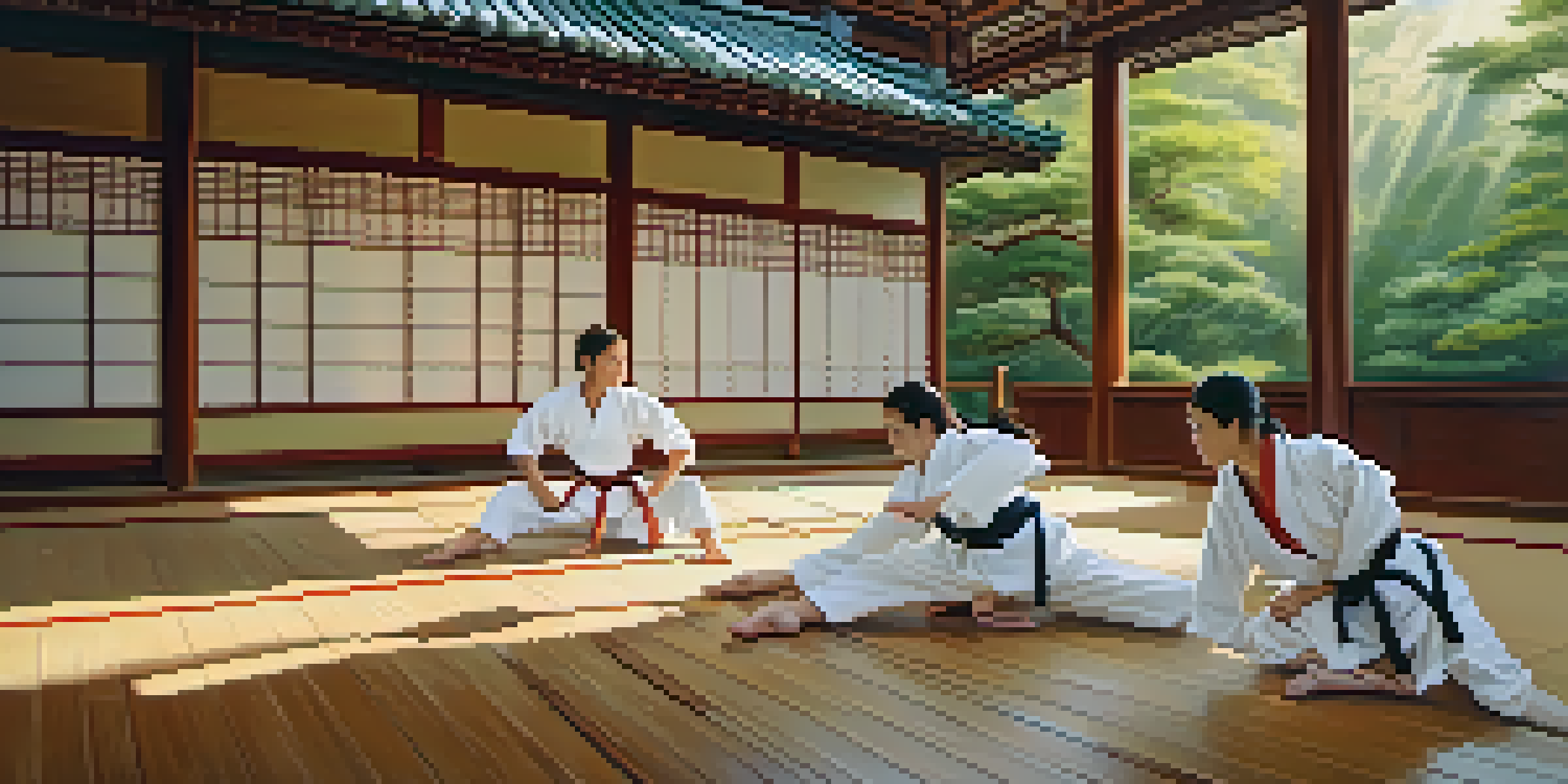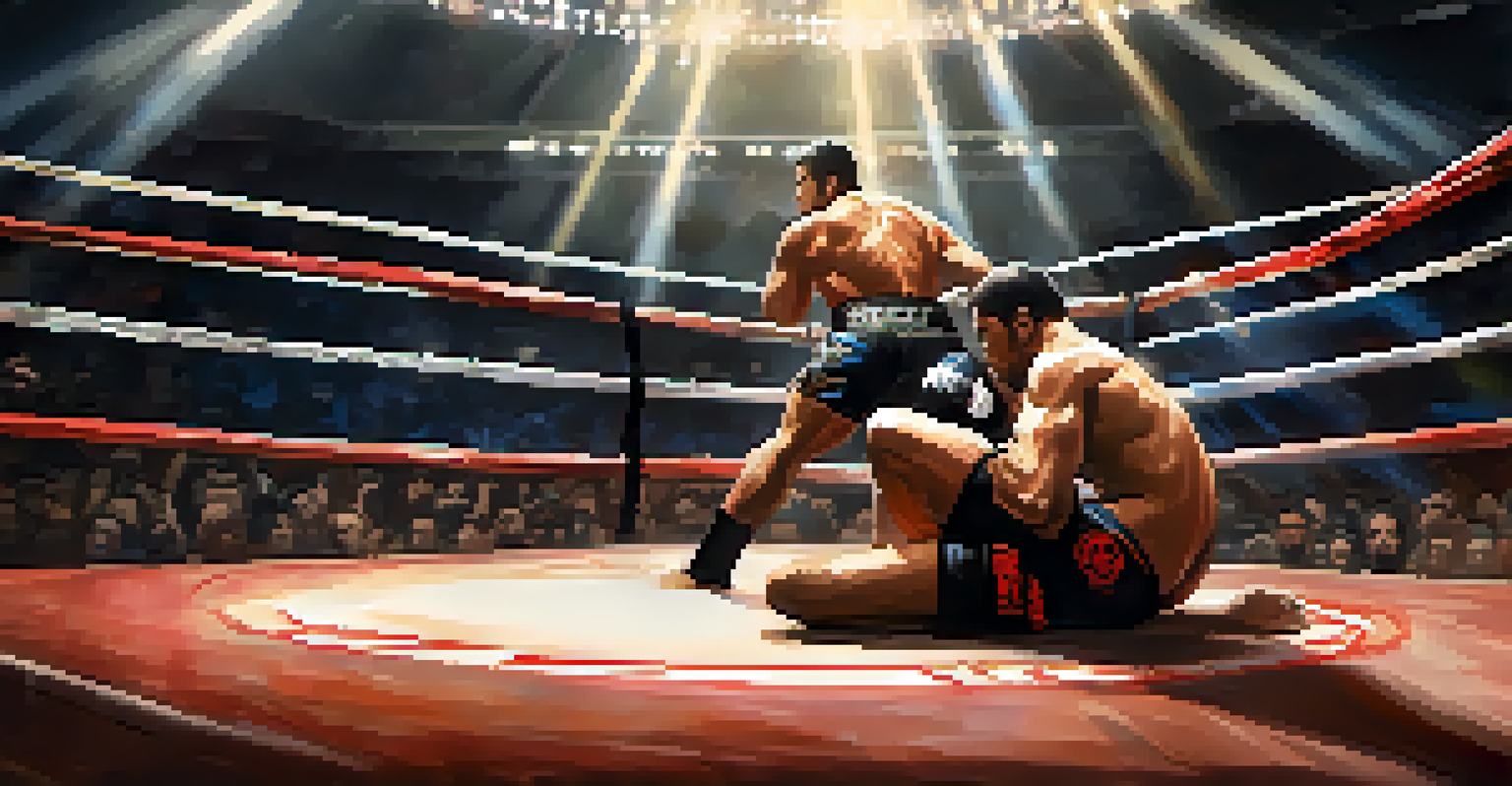Historical Overview of Major Martial Arts Competitions

The Origins of Martial Arts and Early Competitions
Martial arts have deep roots, tracing back thousands of years to ancient civilizations. Early forms of combat training were often tied to military preparation and self-defense. For instance, in ancient China and Greece, warriors practiced various fighting techniques that later evolved into structured forms of martial arts.
The ultimate aim of martial arts is not having to use them.
These early competitions were not just about skill; they were community events that showcased strength and bravery. For example, the Greek Olympic Games featured wrestling and boxing, which were crucial for training soldiers. Similarly, in China, traditional martial arts were often practiced in temples and later showcased in local festivals.
As societies progressed, these competitions became more formalized, leading to the establishment of rules and regulations. This trend set the foundation for the structured competitions we see today, highlighting the blend of sport, culture, and tradition in martial arts.
The Rise of Judo and Its Competitive Framework
Judo emerged in the late 19th century and quickly gained popularity as a competitive sport. Founded by Jigoro Kano in Japan, it emphasized technique and leverage over brute strength, making it accessible to a broader demographic. This innovative approach transformed martial arts competitions by introducing a new set of rules and scoring systems.

The first official judo competition took place in 1882, fostering a spirit of sportsmanship and discipline. This event laid the groundwork for future competitions, including the All-Japan Judo Championships, which began in 1926. These competitions not only showcased skill but also promoted camaraderie among practitioners.
Martial Arts Roots and Evolution
Martial arts have evolved from ancient combat training into structured competitions that blend sport, culture, and tradition.
Judo's inclusion in the 1964 Tokyo Olympics marked a significant milestone, elevating its status on the global stage. This recognition spurred the growth of judo competitions worldwide, inspiring new generations to participate in this dynamic martial art.
Karate's Global Expansion and Tournament Culture
Karate, originating from Okinawa, Japan, began to gain international recognition in the mid-20th century. Its global expansion was fueled by cultural exchange, especially through films and martial arts demonstrations. With its focus on striking techniques, karate quickly became a popular choice for competition.
In martial arts, the spirit of the competition is to uplift and empower, not to diminish or belittle.
The establishment of organizations like the World Karate Federation (WKF) in 1970 helped standardize rules and promote tournaments worldwide. Events such as the World Karate Championships became platforms for practitioners to showcase their skills, fostering a sense of community and competition.
Karate's inclusion in the Olympics in 2020 marked a significant achievement for the martial art, bringing it to a broader audience. This event not only highlighted the dedication of athletes but also solidified karate's place in the history of martial arts competitions.
The Evolution of Taekwondo and Its Competitive Events
Taekwondo, a Korean martial art known for its high-flying kicks and dynamic techniques, saw its formalization in the 1940s and 50s. Competitive taekwondo quickly gained traction, with the first official tournament held in 1961. This marked the start of a structured competition scene that embraced both sport and tradition.
The World Taekwondo Federation (WTF), established in 1973, played a crucial role in promoting taekwondo as a competitive sport. The introduction of electronic scoring systems in recent years has further refined competitions, ensuring fair play and precision in judging.
Rise of Competitive Martial Arts
Disciplines like judo, karate, and taekwondo have developed formal competitive frameworks, gaining international recognition and participation.
Taekwondo's inclusion as an Olympic sport in 2000 showcased its global appeal and competitive nature. Today, championships are held worldwide, attracting practitioners of all ages and skill levels, and emphasizing the sport's commitment to discipline and respect.
The Emergence of Mixed Martial Arts (MMA)
Mixed Martial Arts (MMA) has transformed the landscape of martial arts competitions since its rise in the 1990s. Combining techniques from various disciplines, including boxing, jiu-jitsu, and wrestling, MMA showcases versatility and strategy. The Ultimate Fighting Championship (UFC), founded in 1993, played a pivotal role in popularizing this sport.
MMA events are known for their high-energy bouts and diverse fighting styles, creating a unique and thrilling spectator experience. The promotion of MMA as a legitimate sport has attracted a global audience, elevating fighters to celebrity status and inspiring many to take up martial arts.
The evolution of regulations and safety measures in MMA has also contributed to its mainstream acceptance. With weight classes and medical checks in place, MMA competitions prioritize fighter safety while maintaining the excitement and unpredictability that fans love.
The Role of Technology in Modern Martial Arts Competitions
Technology has significantly influenced martial arts competitions, enhancing training and performance analysis. Video review systems and wearables are now commonplace, allowing athletes to refine their techniques and improve their strategies. This technological integration helps coaches and fighters assess their strengths and weaknesses more effectively.
Live streaming and social media have also revolutionized how competitions are viewed and engaged with. Fans can now watch events in real-time, share highlights, and connect with fighters on platforms like Instagram and Twitter. This increased visibility has contributed to the growing popularity of martial arts.
Future Trends in Martial Arts
The future of martial arts competitions will focus on inclusivity and innovation, embracing new technologies and diverse participation.
Furthermore, virtual reality (VR) and augmented reality (AR) are emerging tools in training and competition preparation. These technologies offer immersive experiences that can enhance skills and provide athletes with innovative ways to visualize techniques and strategies.
The Future of Martial Arts Competitions
As martial arts continue to evolve, so too will the competitions that showcase them. The growing popularity of various styles, including those rooted in cultural traditions, indicates a bright future for martial arts competitions. New forms of competition may arise, blending traditional techniques with modern innovations.
Inclusivity will likely play a significant role in the future of martial arts, encouraging participation from diverse backgrounds and communities. Programs aimed at promoting martial arts for youth and underrepresented groups are already making strides, fostering a sense of unity and empowerment.

Ultimately, the future of martial arts competitions will be shaped by the dedication of practitioners and the evolving landscape of sport. As new generations embrace martial arts, the spirit of competition will continue to thrive, ensuring that these traditions remain alive and well.